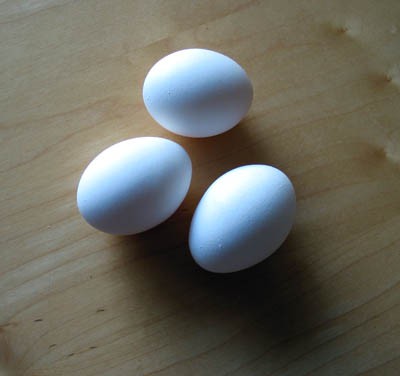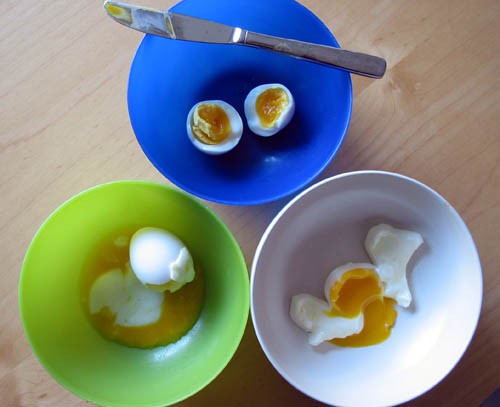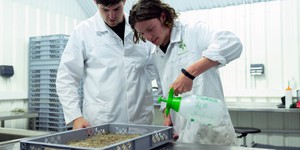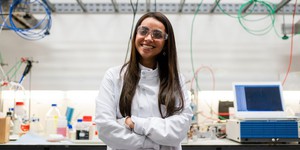Abstract
Sometimes on a busy day, it is hard to get things done. The rush to get things done can start first thing in the morning, when you are so busy getting ready and gathering your homework, that you barely have time for breakfast. It takes time to get a nutritious meal ready. But, eggs are a perfect choice for breakfast because they can be cooked quickly and in many different ways. A soft-boiled egg is a choice that many people make. They like the way the thickened, tasty yolk coats their hash browns or toast. In this cooking and food science fair project, you will determine the best recipe for producing consistent, soft-boiled eggs that will get your day off to a great start!Summary
Michelle Maranowski, PhD, Science Buddies

Objective
To scientifically determine the best method for consistently producing the best soft-boiled egg.
Introduction
The typical egg packs a lot of punch in a small package. One large egg has about 75 calories and 13 essential nutrients, including high-quality protein, various vitamins, choline, folate, riboflavin, and multiple minerals (including zinc and iron). Eggs can help you maintain muscle strength, as well as promote a healthy pregnancy, brain function, and eye health. Eaten in moderation, eggs have shown no link to cardiovascular disease or stroke in a healthy population, according to some studies. The egg is a nutrient-dense food product that is eaten by people all over the world. In fact, humans have been eating eggs for thousands of years. Egyptian and Chinese records show humans eating eggs in 1400 BC.
There are about 200 breeds of chickens around the world today. Most of the eggs eaten in the United States are from the Single-Comb Leghorn breed. The United States produces 75 billion eggs per year! What is really amazing is that most eggs reach the supermarket just a few days after being laid.
The main components of an egg are the shell, the air cell, the albumen (or egg white), and the yolk. The yolk contains all of the fat of the egg, most of the vitamins and minerals, and about half of the protein. The albumen or egg white is mostly water (about 90 percent) and protein (about 10 percent). People who are limiting their fat intake can eat egg whites, since egg whites contain no fat.
There are several methods for preparing eggs. Eggs can be scrambled, poached, fried, pickled, hard-boiled, and soft-boiled. In a raw egg, the proteins in the egg are folded and curled up tight, but when you cook an egg by heating it, the heat causes the proteins in the egg to uncurl so that they interact with each other, forming a network of connected proteins. This is why an egg changes how it does when you cook it. You have probably often heard of hard-boiled eggs, but what is a soft-boiled egg? The white of a soft-boiled egg is firm, but the yolk is between runny and solid. It should be viscous, or thickened and sticky. In this cooking and food science project, you will develop a recipe for creating the best soft-boiled egg in the least amount of time. You will experiment with three different cooking methods: (1) cooking the egg in boiling water, (2) steeping the egg in boiling water and (3) placing the egg in cool water and then boiling it for a set amount of time. Try to determine the best, shortest, and most consistent way to soft-boil an egg. Get ready to perfect your recipe!
 Image Credit: Michelle Maranowski, Science Buddies / Science Buddies
Image Credit: Michelle Maranowski, Science Buddies / Science Buddies
Figure 1. Delicious and nutritious eggs.
Terms and Concepts
- Calorie
- Nutrient
- Protein
- Vitamin
- Mineral
- Viscous
Questions
- How many different grades of eggs are there? How are they sorted?
- What is the anatomy of an egg?
- How does applying heat to a raw egg change it from being raw to being cooked?
Bibliography
- Exploratorium. (n.d.). Anatomy of an Egg. Retrieved March 14, 2013.
- Chu, M. (2008, August 25). Soft Boiled Eggs. Retrieved November 6, 2008.
This website has great information on a variety of egg-related topics:
- American Egg Board. (2007). Incredible!. Retrieved November 4, 2008.
Materials and Equipment
- Pot, 3-quart with lid, should be large enough to hold at least one egg submerged in water
- Eggs (3 dozen), choose one grade and size to use for the entire project.
- Water
- Stove top
- Slotted spoon
- Digital timer
- Bowl, glass
- Ice cubes
- Disposable bowls (2 packages)
- Ruler with millimeter divisions
- Camera
- Lab notebook
Experimental Procedure
Important Notes Before You Begin
-
If your eggs are in the refrigerator, take them out and bring them to room temperature before you begin any testing.
- This may take about an hour.
- There is a chance that eggs can carry a bacteria called Salmonella. Salmonella can cause severe food poisoning. The Centers for Disease Control and Prevention (CDC) recommend avoiding eating eggs unless the whites and yolks are both firmly cooked. For this reason, we do not recommend eating the soft-boiled eggs in this science project; just make observations. If you would like to eat them, consider doing your science project with pasteurized eggs.
-
When asked to make observations about your results, use your senses. You may want to make a data table in your lab notebook to record your observations and answer the following questions:
-
Examine the egg white. Is it firm or watery? Measure the thickness of the solid white with a ruler.
- When you peel the egg, depending on how the egg was cooked the solid white may be along the inside of the shell or still attached to the yolk.
- If the thickness of the solid white seems to vary around the egg, try to measure the thinnest and thickest areas and record that range.
- Examine the yolk. Try poking your finger into it. Does it feel slimy (raw), viscous (thickened and sticky), or hard (cooked solid)? What color is it? Is it pale yellow or bright yellow?
- Overall, does it seem like the egg is soft-boiled? If not, does it seem undercooked or overcooked?
-
Examine the egg white. Is it firm or watery? Measure the thickness of the solid white with a ruler.
- Remember to always wash your hands with soap and warm water after handling eggs that are not cooked.
Cooking Method 1: Cooking the Egg in Boiling Water
- In your lab notebook, record the cooking method you are using.
- To first get the correct amount of water in the pot, place an egg in the pot and add water. Make sure that the egg is covered with about 1 inch of water. Remove the egg.
- Place the pot of water on the stove top, cover, and bring it to a boil. Keep an eye on the pot so you know when the water starts to boil. Heat the pot until the water is bubbling vigorously. In your lab notebook, record the stove top setting and the time required for the water to boil.
- Using the slotted spoon, carefully lower an egg into the boiling water. Carefully remove the slotted spoon. You want to make sure that the shell does not crack. If the shell does crack, you will have to start again.
- Set the digital timer for 2 minutes and boil the egg for 2 minutes. Keep the lid on the pot while the egg boils.
-
While the egg is boiling, place a few cubes of ice in the glass bowl and fill it with enough water that it will cover the egg. This is an ice-water bath.
- Putting the egg in the ice-water bath will stop the egg from cooking more.
- Once 2 minutes have elapsed, carefully remove the egg with the slotted spoon and carefully transfer it to the ice-water bath, letting it soak for 1 minute. Turn off the stove.
- After 1 minute has elapsed, take the egg out of the water bath and peel it. Place the peeled egg in a disposable bowl. Evaluate the egg based on the information in the Important Notes section at the beginning of the Experimental Procedure. Record your observations in your lab notebook, along with the amount of time that the egg was cooked. Take pictures of your results and keep them in your lab notebook.
- Repeat steps 1–8 two more times. Each time, making sure that you use approximately the same amount of water and the same heat setting on the stove top. Also use a new disposable bowl for each egg.
- Repeat steps 1–9, but increase the cooking time by 2 minutes for a total of 4 minutes.
- Repeat steps 1–9 again, but increase the cooking time by 2 more minutes for a total of 6 minutes of cooking time.
Cooking Method 2: Steeping the Egg in Boiling Water
- In your lab notebook, record the cooking method you are using.
- To first get the correct amount of water in the pot, place an egg in the pot and add water. Make sure that the egg is covered with about 1 inch of water. Remove the egg.
- Place the pot of water on the stove top, cover, and bring it to a boil. Keep an eye on the pot so you know when the water starts to boil. Heat the pot until the water is bubbling vigorously. In your lab notebook, record the stove top setting and the time required for the water to boil.
- Using the slotted spoon, carefully lower an egg into the boiling water. Carefully remove the slotted spoon. You want to make sure that the shell does not crack. If the shell does crack, you will have to start again. Once the egg is submerged, turn off the stove and move the pot to a cool burner.
- Set the timer for 2 minutes and steep the egg in the just-boiled water for 2 minutes. Leave the lid off the pot while the egg steeps.
- While the egg is steeping, place a few ice cubes in the glass bowl and fill it with enough water that it will cover the egg.
- After 2 minutes have elapsed, carefully remove the egg from the pot with the slotted spoon and place it into the ice water bath. Let the egg sit in the ice-water bath for 1 minute.
- After 1 minute has elapsed, remove the egg from the ice-water bath and peel the egg. Place the peeled egg in a disposable bowl. Evaluate the egg based on the information in the Important Notes section at the beginning of the Experimental Procedure. Record your observations in your lab notebook, along with the amount of time that the egg was cooked. Take pictures of your results and keep them in your lab notebook.
- Repeat steps 1–8 two more times. Each time, making sure that you use approximately the same amount of water and the same heat setting on the stove top.
- Repeat steps 1–9, but increase the steeping time by 2 minutes for a total of 4 minutes.
- Repeat steps 1–9 again, but increase the steeping time by 2 minutes for a total of 6 minutes of steeping time.
Cooking Method 3: Bringing the Egg and Water Up to a Boil Together
- In your lab notebook, record the cooking method you are using.
- To first get the correct amount of water in the pot, place an egg in the pot and add water. Make sure that the egg is covered with about 1 inch of water. This time, do not remove the egg.
- Place the pot of water and the egg on the stove top, cover, and bring it to a boil. Keep an eye on the pot so you know when the water starts to boil. Let the water start to bubble vigorously. In your lab notebook, record the stove top setting and the time required for the water to boil.
- Once the water is vigorously boiling, set the timer for 2 minutes and boil the egg for 2 minutes. Keep the lid on the pot while the egg boils.
- While the egg is boiling, place a few ice cubes in the glass bowl and fill it with enough water that it will cover the egg.
- After 2 minutes have elapsed, carefully remove the egg from the pot with the slotted spoon and place it into the ice-water bath. Let the egg sit in the ice-water bath for 1 minute.
- After 1 minute has elapsed, remove the egg from the ice-water bath and peel the egg. Place the peeled egg in a disposable bowl. Evaluate the egg based on the information in the Important Notes section at the beginning of the Experimental Procedure. Record your observations in your lab notebook, along with the amount of time that the egg was cooked. Take pictures of your results and keep them in your lab notebook.
- Repeat steps 1–7 two more times. Each time, making sure that you use approximately the same amount of water and the same heat setting on the stove top.
- Repeat steps 1–8, but increase the boiling time by 2 minutes, for a total of 4 minutes.
- Repeat steps 1–8 again, but increase the boiling time by 2 minutes for a total of 6 minutes of boiling time.
Analyzing Your Data
- Compare the observations and pictures from the three sections above. Is there a recipe that consistently produces the best soft-boiled egg results? If you have results that are similar, you can evaluate which recipe is the better one. Do either of the recipes use less energy than the others?
 Image Credit: Michelle Maranowski, Science Buddies / Science Buddies
Image Credit: Michelle Maranowski, Science Buddies / Science Buddies
Figure 2. Eggs cooked using the three different methods in the Experimental Procedure.
Ask an Expert
Variations
- Use an infrared thermometer, which can be purchased online, to measure the temperature of the egg white and yolk after boiling. Record the data in your lab notebook. How hot do the eggs get when using the different cooking methods?
- Does the time to soft-boil an egg depend on the size of the egg? Pick three different sizes of eggs and start experimenting.
- Does freshness of the egg affect the time it takes to soft-boil it? Get fresh eggs and try this experiment on some of the eggs right after obtaining them, and then try it again after you have let some of the same batch of eggs sit in the refrigerator for a few weeks. Is there a difference?
- Eggs are often soft-boiled in water that is not quite boiling, but is instead simmering. You could try this experiment again but this time use simmering water instead of vigorously boiling water. How does this affect how well the eggs are cooked? Can you perfect your soft-boiled egg recipe even more?
Careers
If you like this project, you might enjoy exploring these related careers:








